IN MEMORY OF ALBERTO BOREA AT ISABEL HURLEY
Isabel Hurley Gallery in Malaga dedicates an exhibition as a tribute to Alberto Borea (Lima, Peru, 1971- ibidem, 2020). El negro estuvo aquí (2008-2013) goes through his last five years of production through a selection of representative works that were part of the solo shows Ruinas y ciudades, Mountains of America and Turista El Dorado, all of them exhibitions that the Peruvian made in this same gallery, in addition to the proposals made to be exhibited in Volta NY 2011 and ARCO 2013.
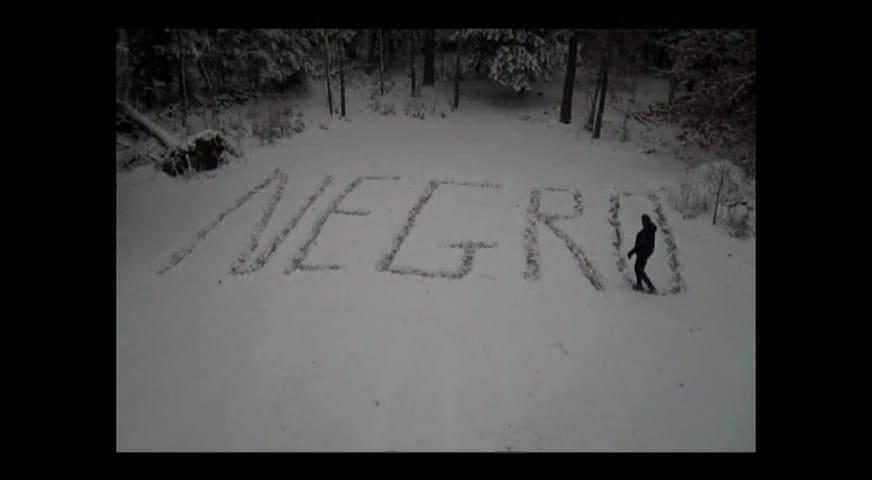
Underlying the exhibition idea is his permanent presence in what was one of his favorite spaces. It was in this gallery where he exhibited for the first time in Spain and became a regular of it. Within this expressed recognition, the collaboration between gallery owner and artist also emerges, showing their empathy to consolidate both projects, the personal and the professional.
The motif of remembrance and the anthological structure of his last stage run throughout the exhibition, from the title itself, which leads us to the locative, but also alludes to the nickname by which Borea's relatives called the artist. However, that “negro” goes beyond, and represents a personal and a political part, both fundamental in his production. Therein lies the essence of the video Mountains of America (Negro) (2010), a piece that records the intervention on a snowy landscape of Vermont (USA) and that results in the materialization of the word executed with the foot.
Borea's work is characterized by the use of diverse media and materials that represent his openness and curiosity for the use of them in his proposal, giving vital importance to language, technique and process. Objects become a starting point, and through them he formalizes his research on the formal, without forgetting a certain semiotic analysis framed in a social, economic and production framework.
Thus, the everyday is transformed into popular imaginary, almost iconic, approaching (or mimicking) the issues of both the industry and the communicative and contextual edges that emanate from it. There are pieces, such as Huaco (2013), in which the opposite dialogues, whether this contradiction is the result of the place, the exogenous or time, while others, such as Autopistas (2008), propose an analysis of conscience between progress and its price and aim to establish a necessary critical debate on the need to preserve the origin and tradition within the urban maelstrom and global hegemony.
Along the same lines, he also presents a detailed vision of the phenomena of emigration and identity from his own experience. On these elements he developed a personal cartography, visible in some of his series, but also served as a point of conjunction to use other concepts as part of that critical narrative that leads to architecture or economic, urban and gentrification trends to be an intrinsic part of the discussion. Real State I and Real State II (2010) would be an example of this visible change.
Alberto Borea uses his own language that mixes the international with his cultural roots, the primitive and the contemporary, which can lead to a certain complexity. It is so because of his visions, multiple readings and derivatives of his concepts, as well as everything exposed in terms of techniques and instrumentalization of the object, of creation or of the imaginary.
-
Alberto Borea_ El negro estuvo aquí (2008-2013)_ Isabel Hurley_ 0
-
Alberto Borea_ El negro estuvo aquí (2008-2013)_ Isabel Hurley_ 0
-
Alberto Borea_ El negro estuvo aquí (2008-2013)_ Isabel Hurley_ 1
-
Alberto Borea_ El negro estuvo aquí (2008-2013)_ Isabel Hurley_ 2
-
Alberto Borea_ El negro estuvo aquí (2008-2013)_ Isabel Hurley_ 3
-
Alberto Borea_ El negro estuvo aquí (2008-2013)_ Isabel Hurley_ 4
-
Alberto Borea_ El negro estuvo aquí (2008-2013)_ Isabel Hurley_ 5
-
Alberto Borea_ El negro estuvo aquí (2008-2013)_ Isabel Hurley_ 6
El negro estuvo aquí (2008-2013) can be seen until December 20 at Isabel Hurley Gallery, Reding, 39, Malaga (Spain).
May interest you
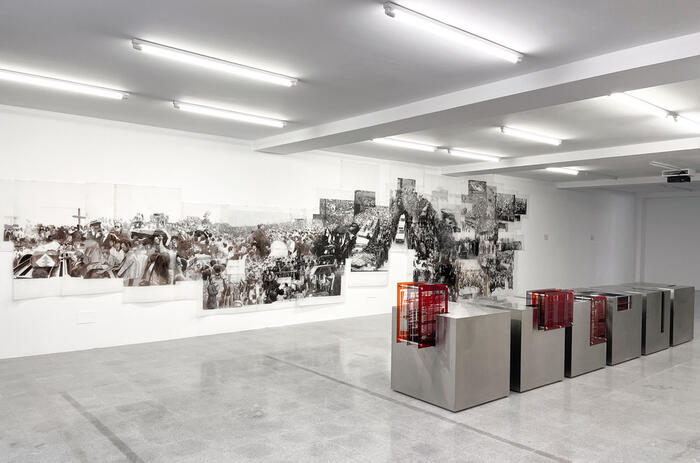
The work of Voluspa Jarpa (Rancagua, Chile, 1971) has had a very preeminent focus on the political concept surrounding archiving and its documents. Attracted to investigate more about its multiple meanings as a result of the declassification of secrets, specifically the one carried out by the Clinton administration regarding the 1973 coup d'état against Salvador Allende, the artist begins a discursive investigation on the importance of the archival support and the materiality it has as a political document, which leads her to qualify that presupposed legibility.

The work of Voluspa Jarpa (Rancagua, Chile, 1971) has had a very preeminent focus on the political concept surrounding archiving and its documents. Attracted to investigate more about its multiple meanings as a result of the declassification of secrets, specifically the one carried out by the Clinton administration regarding the 1973 coup d'état against Salvador Allende, the artist begins a discursive investigation on the importance of the archival support and the materiality it has as a political document, which leads her to qualify that presupposed legibility.
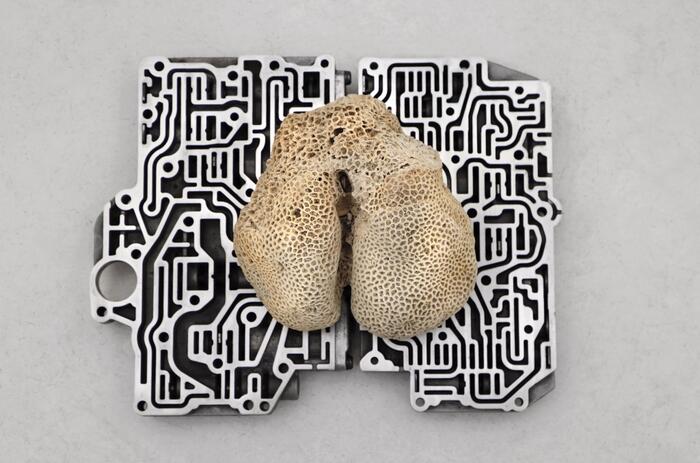
The work Nicolás Lamas (Lima, Peru, 1980) presents at The Goma Galery in his solo show Flujos atemporales/sedimentos cognitivos is circumscribed to his way of understanding relationships in a network of knowledge that involves the worlds of the natural and the cultural. Both spheres are the ones that lead him to use in his production processes different materials, artificial and organic, with which he gives life to hybrid elements that have an impact on the viewer's perception.
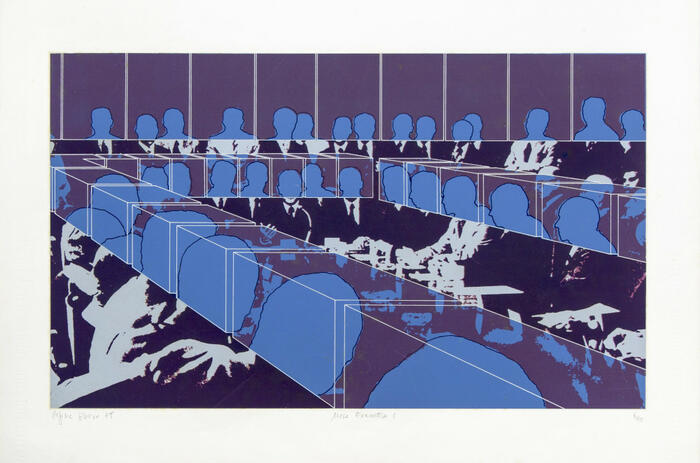
Barcelona's Center of Image La Virreina (La Virreina Centre de la Imatge) is dedicating an extensive exhibition to Regina Silveira (Porto Alegre, Brazil, 1939), one of the multimedia artists and key figures of Latin American conceptual art. Within the exhibition line of the center, which advocates the exploration of the aesthetic and ideological languages of images, this show curated by Isabella Lenzi covers a wide range of the Brazilian artist's research, experimentation and artistic production, particularly that developed with technical reproduction techniques and the circulation of images.
REGINA SILVEIRA'S DESTRUCTION OF POWER
Barcelona's Center of Image La Virreina (La Virreina Centre de la Imatge) is dedicating an extensive exhibition to Regina Silveira (Porto Alegre, Brazil, 1939), one of the multimedia artists and key figures of Latin American conceptual art. Within the exhibition line of the center, which advocates the exploration of the aesthetic and ideological languages of images, this show curated by Isabella Lenzi covers a wide range of the Brazilian artist's research, experimentation and artistic production, particularly that developed with technical reproduction techniques and the circulation of images.
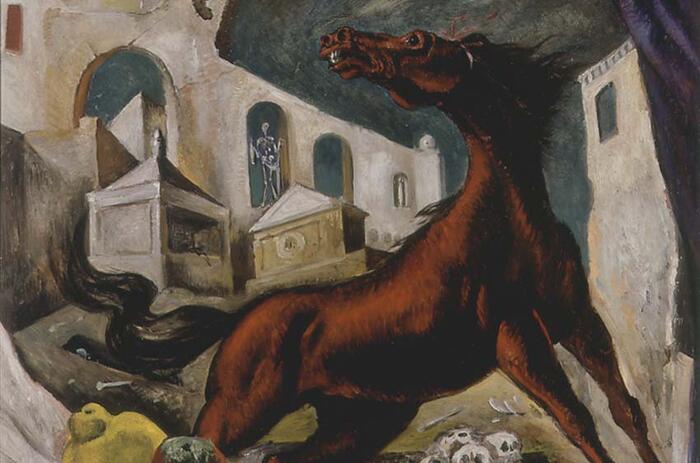
Fundación Casa de Mexico in Spain hosts the exhibition Modern Art of Mexico, with funds from the Blaisten Collection and curated by Daniel Garza Usabiaga, which takes an interesting look at the country's 20th century production through the eyes of Margarita Nelken (Madrid, Spain, 1894-Mexico City, Mexico, 1968).
MEXICAN MODERN ART ACCORDING TO NELKEN AND THE BLAISTEN COLLECTION
Fundación Casa de Mexico in Spain hosts the exhibition Modern Art of Mexico, with funds from the Blaisten Collection and curated by Daniel Garza Usabiaga, which takes an interesting look at the country's 20th century production through the eyes of Margarita Nelken (Madrid, Spain, 1894-Mexico City, Mexico, 1968).
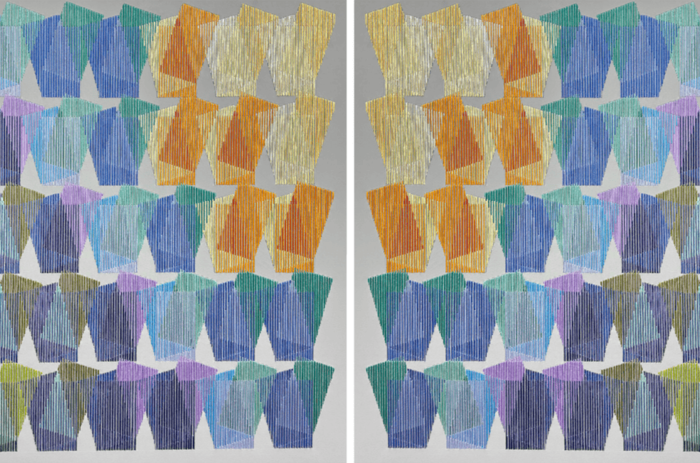
Isabella Despujols (Barquisemeto, Venezuela, 1994), Venezuelan artist based in Brazil, uses her artistic references for the realization of her latest series of works, a set made this year where textiles and embroidery are especially relevant, as well as the formal fact that they reflect. In them is palpable the conversation that he intends to maintain with those styles and languages that were fundamental in the countries to which he circumscribes his personal experience.
DESPUJOLS' EMBROIDERED GEOMETRY AT LLAMAZARES
Isabella Despujols (Barquisemeto, Venezuela, 1994), Venezuelan artist based in Brazil, uses her artistic references for the realization of her latest series of works, a set made this year where textiles and embroidery are especially relevant, as well as the formal fact that they reflect. In them is palpable the conversation that he intends to maintain with those styles and languages that were fundamental in the countries to which he circumscribes his personal experience.
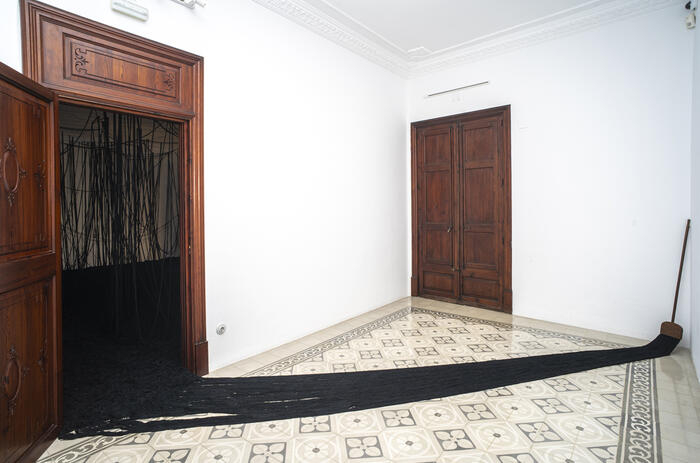
ALTTRA Foundation organizes in three spaces in Palma, on the island of Mallorca, an exhibition that addresses the theme of insularity and its role and idiosyncrasy in a globalized world through several works by Cildo Meireles (Rio de Janeiro, Brazil, 1948). The works chosen, corresponding to five different periods of the artistic production of one of the referents of Brazilian neo-conceptualism, trace a journey through some of the themes and investigations that the artist has developed throughout his life, from fortune and chance to the perception of the physically invisible but perceptible, such as sound, or the relationship between space and its use.
CILDO MEIRELES EN PALMA DE MALLORCA
ALTTRA Foundation organizes in three spaces in Palma, on the island of Mallorca, an exhibition that addresses the theme of insularity and its role and idiosyncrasy in a globalized world through several works by Cildo Meireles (Rio de Janeiro, Brazil, 1948). The works chosen, corresponding to five different periods of the artistic production of one of the referents of Brazilian neo-conceptualism, trace a journey through some of the themes and investigations that the artist has developed throughout his life, from fortune and chance to the perception of the physically invisible but perceptible, such as sound, or the relationship between space and its use.
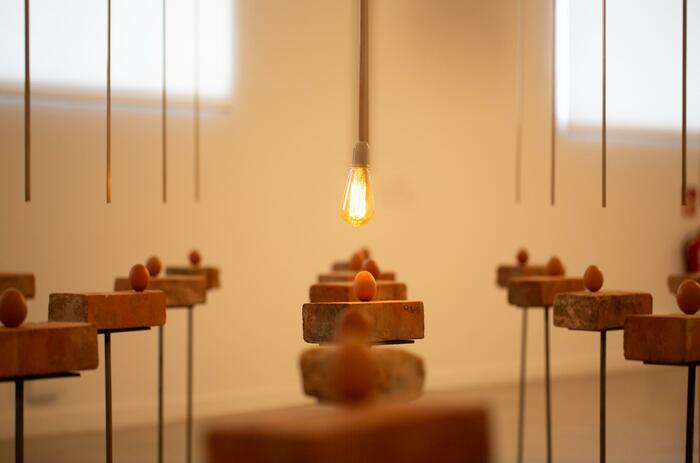
Contemplando es como fuimos cambiando (Contemplating is how we changed) is the exhibition, the first one in Spain promoted by an institution, that the CICC Tabakalera in San Sebastian is dedicating to Gabriel Chaile (San Miguel de Tucumán, Argentina, 1985), one of the most prominent names in contemporary Latin American sculpture. This proposal is intended to take an extensive look at his work, from his beginnings to his latest works produced in Lisbon, and which is recognizable by his monumental adobe, clay and metal pieces that reflect the morphology of the pre-Columbian ceramics of his native region.
GABRIEL CHAILE’S SCULPTURE AT TABAKALERA
Contemplando es como fuimos cambiando (Contemplating is how we changed) is the exhibition, the first one in Spain promoted by an institution, that the CICC Tabakalera in San Sebastian is dedicating to Gabriel Chaile (San Miguel de Tucumán, Argentina, 1985), one of the most prominent names in contemporary Latin American sculpture. This proposal is intended to take an extensive look at his work, from his beginnings to his latest works produced in Lisbon, and which is recognizable by his monumental adobe, clay and metal pieces that reflect the morphology of the pre-Columbian ceramics of his native region.
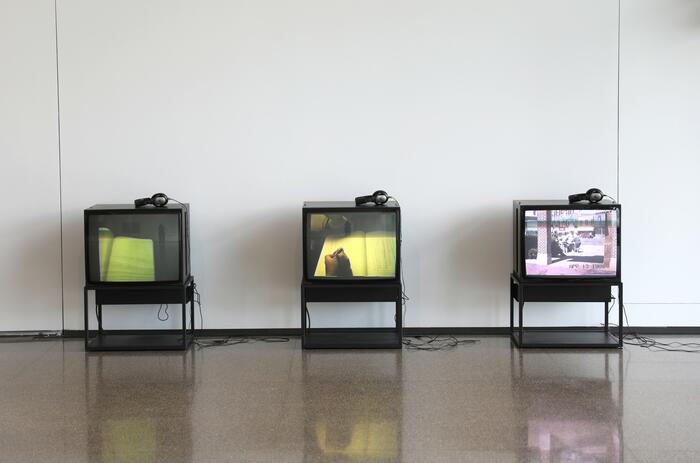
The exhibition Contar Rutinas (Counting Routines) dedicated by the Cerezales Antonino and Cinia Foundation to the work of Ana Amorim (São Paulo, Brazil, 1956) includes a selection of actions and performative works and installations that reflect the activity of the Brazilian artist from the 1980s to the present. The architecture of this exhibition is marked by the artist's daily conceptual and performative routines, reflecting their influence in the results of monumental dimensions.
ANA AMORIM'S REGISTER OF THE ROUTINE
The exhibition Contar Rutinas (Counting Routines) dedicated by the Cerezales Antonino and Cinia Foundation to the work of Ana Amorim (São Paulo, Brazil, 1956) includes a selection of actions and performative works and installations that reflect the activity of the Brazilian artist from the 1980s to the present. The architecture of this exhibition is marked by the artist's daily conceptual and performative routines, reflecting their influence in the results of monumental dimensions.
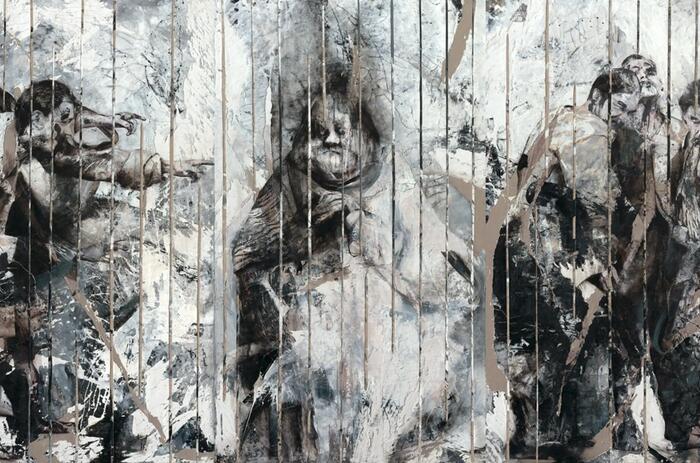
Goya's Los Disparates preceded, or marked, painting's entry into modernity. Beyond this historiographical note, the series by the Aragonese master captures with masterful imagery the vicissitudes of irony, sarcasm and the darkness of a reality that has lasted through time to the present day. The plates of his etchings become the surface that deposits this reality, and the result, once impregnated, works as a full reminder of the origin of our essence, our fears and our actions.
LITA CABELLUT IN DIALOGUE WITH GOYA
Goya's Los Disparates preceded, or marked, painting's entry into modernity. Beyond this historiographical note, the series by the Aragonese master captures with masterful imagery the vicissitudes of irony, sarcasm and the darkness of a reality that has lasted through time to the present day. The plates of his etchings become the surface that deposits this reality, and the result, once impregnated, works as a full reminder of the origin of our essence, our fears and our actions.

The work of Voluspa Jarpa (Rancagua, Chile, 1971) has had a very preeminent focus on the political concept surrounding archiving and its documents. Attracted to investigate more about its multiple meanings as a result of the declassification of secrets, specifically the one carried out by the Clinton administration regarding the 1973 coup d'état against Salvador Allende, the artist begins a discursive investigation on the importance of the archival support and the materiality it has as a political document, which leads her to qualify that presupposed legibility.

The work Nicolás Lamas (Lima, Peru, 1980) presents at The Goma Galery in his solo show Flujos atemporales/sedimentos cognitivos is circumscribed to his way of understanding relationships in a network of knowledge that involves the worlds of the natural and the cultural. Both spheres are the ones that lead him to use in his production processes different materials, artificial and organic, with which he gives life to hybrid elements that have an impact on the viewer's perception.

Barcelona's Center of Image La Virreina (La Virreina Centre de la Imatge) is dedicating an extensive exhibition to Regina Silveira (Porto Alegre, Brazil, 1939), one of the multimedia artists and key figures of Latin American conceptual art. Within the exhibition line of the center, which advocates the exploration of the aesthetic and ideological languages of images, this show curated by Isabella Lenzi covers a wide range of the Brazilian artist's research, experimentation and artistic production, particularly that developed with technical reproduction techniques and the circulation of images.
REGINA SILVEIRA'S DESTRUCTION OF POWER
Barcelona's Center of Image La Virreina (La Virreina Centre de la Imatge) is dedicating an extensive exhibition to Regina Silveira (Porto Alegre, Brazil, 1939), one of the multimedia artists and key figures of Latin American conceptual art. Within the exhibition line of the center, which advocates the exploration of the aesthetic and ideological languages of images, this show curated by Isabella Lenzi covers a wide range of the Brazilian artist's research, experimentation and artistic production, particularly that developed with technical reproduction techniques and the circulation of images.

Fundación Casa de Mexico in Spain hosts the exhibition Modern Art of Mexico, with funds from the Blaisten Collection and curated by Daniel Garza Usabiaga, which takes an interesting look at the country's 20th century production through the eyes of Margarita Nelken (Madrid, Spain, 1894-Mexico City, Mexico, 1968).
MEXICAN MODERN ART ACCORDING TO NELKEN AND THE BLAISTEN COLLECTION
Fundación Casa de Mexico in Spain hosts the exhibition Modern Art of Mexico, with funds from the Blaisten Collection and curated by Daniel Garza Usabiaga, which takes an interesting look at the country's 20th century production through the eyes of Margarita Nelken (Madrid, Spain, 1894-Mexico City, Mexico, 1968).

Isabella Despujols (Barquisemeto, Venezuela, 1994), Venezuelan artist based in Brazil, uses her artistic references for the realization of her latest series of works, a set made this year where textiles and embroidery are especially relevant, as well as the formal fact that they reflect. In them is palpable the conversation that he intends to maintain with those styles and languages that were fundamental in the countries to which he circumscribes his personal experience.
DESPUJOLS' EMBROIDERED GEOMETRY AT LLAMAZARES
Isabella Despujols (Barquisemeto, Venezuela, 1994), Venezuelan artist based in Brazil, uses her artistic references for the realization of her latest series of works, a set made this year where textiles and embroidery are especially relevant, as well as the formal fact that they reflect. In them is palpable the conversation that he intends to maintain with those styles and languages that were fundamental in the countries to which he circumscribes his personal experience.

ALTTRA Foundation organizes in three spaces in Palma, on the island of Mallorca, an exhibition that addresses the theme of insularity and its role and idiosyncrasy in a globalized world through several works by Cildo Meireles (Rio de Janeiro, Brazil, 1948). The works chosen, corresponding to five different periods of the artistic production of one of the referents of Brazilian neo-conceptualism, trace a journey through some of the themes and investigations that the artist has developed throughout his life, from fortune and chance to the perception of the physically invisible but perceptible, such as sound, or the relationship between space and its use.
CILDO MEIRELES EN PALMA DE MALLORCA
ALTTRA Foundation organizes in three spaces in Palma, on the island of Mallorca, an exhibition that addresses the theme of insularity and its role and idiosyncrasy in a globalized world through several works by Cildo Meireles (Rio de Janeiro, Brazil, 1948). The works chosen, corresponding to five different periods of the artistic production of one of the referents of Brazilian neo-conceptualism, trace a journey through some of the themes and investigations that the artist has developed throughout his life, from fortune and chance to the perception of the physically invisible but perceptible, such as sound, or the relationship between space and its use.

Contemplando es como fuimos cambiando (Contemplating is how we changed) is the exhibition, the first one in Spain promoted by an institution, that the CICC Tabakalera in San Sebastian is dedicating to Gabriel Chaile (San Miguel de Tucumán, Argentina, 1985), one of the most prominent names in contemporary Latin American sculpture. This proposal is intended to take an extensive look at his work, from his beginnings to his latest works produced in Lisbon, and which is recognizable by his monumental adobe, clay and metal pieces that reflect the morphology of the pre-Columbian ceramics of his native region.
GABRIEL CHAILE’S SCULPTURE AT TABAKALERA
Contemplando es como fuimos cambiando (Contemplating is how we changed) is the exhibition, the first one in Spain promoted by an institution, that the CICC Tabakalera in San Sebastian is dedicating to Gabriel Chaile (San Miguel de Tucumán, Argentina, 1985), one of the most prominent names in contemporary Latin American sculpture. This proposal is intended to take an extensive look at his work, from his beginnings to his latest works produced in Lisbon, and which is recognizable by his monumental adobe, clay and metal pieces that reflect the morphology of the pre-Columbian ceramics of his native region.

The exhibition Contar Rutinas (Counting Routines) dedicated by the Cerezales Antonino and Cinia Foundation to the work of Ana Amorim (São Paulo, Brazil, 1956) includes a selection of actions and performative works and installations that reflect the activity of the Brazilian artist from the 1980s to the present. The architecture of this exhibition is marked by the artist's daily conceptual and performative routines, reflecting their influence in the results of monumental dimensions.
ANA AMORIM'S REGISTER OF THE ROUTINE
The exhibition Contar Rutinas (Counting Routines) dedicated by the Cerezales Antonino and Cinia Foundation to the work of Ana Amorim (São Paulo, Brazil, 1956) includes a selection of actions and performative works and installations that reflect the activity of the Brazilian artist from the 1980s to the present. The architecture of this exhibition is marked by the artist's daily conceptual and performative routines, reflecting their influence in the results of monumental dimensions.

Goya's Los Disparates preceded, or marked, painting's entry into modernity. Beyond this historiographical note, the series by the Aragonese master captures with masterful imagery the vicissitudes of irony, sarcasm and the darkness of a reality that has lasted through time to the present day. The plates of his etchings become the surface that deposits this reality, and the result, once impregnated, works as a full reminder of the origin of our essence, our fears and our actions.
LITA CABELLUT IN DIALOGUE WITH GOYA
Goya's Los Disparates preceded, or marked, painting's entry into modernity. Beyond this historiographical note, the series by the Aragonese master captures with masterful imagery the vicissitudes of irony, sarcasm and the darkness of a reality that has lasted through time to the present day. The plates of his etchings become the surface that deposits this reality, and the result, once impregnated, works as a full reminder of the origin of our essence, our fears and our actions.

The work of Voluspa Jarpa (Rancagua, Chile, 1971) has had a very preeminent focus on the political concept surrounding archiving and its documents. Attracted to investigate more about its multiple meanings as a result of the declassification of secrets, specifically the one carried out by the Clinton administration regarding the 1973 coup d'état against Salvador Allende, the artist begins a discursive investigation on the importance of the archival support and the materiality it has as a political document, which leads her to qualify that presupposed legibility.

The work Nicolás Lamas (Lima, Peru, 1980) presents at The Goma Galery in his solo show Flujos atemporales/sedimentos cognitivos is circumscribed to his way of understanding relationships in a network of knowledge that involves the worlds of the natural and the cultural. Both spheres are the ones that lead him to use in his production processes different materials, artificial and organic, with which he gives life to hybrid elements that have an impact on the viewer's perception.

Barcelona's Center of Image La Virreina (La Virreina Centre de la Imatge) is dedicating an extensive exhibition to Regina Silveira (Porto Alegre, Brazil, 1939), one of the multimedia artists and key figures of Latin American conceptual art. Within the exhibition line of the center, which advocates the exploration of the aesthetic and ideological languages of images, this show curated by Isabella Lenzi covers a wide range of the Brazilian artist's research, experimentation and artistic production, particularly that developed with technical reproduction techniques and the circulation of images.
REGINA SILVEIRA'S DESTRUCTION OF POWER
Barcelona's Center of Image La Virreina (La Virreina Centre de la Imatge) is dedicating an extensive exhibition to Regina Silveira (Porto Alegre, Brazil, 1939), one of the multimedia artists and key figures of Latin American conceptual art. Within the exhibition line of the center, which advocates the exploration of the aesthetic and ideological languages of images, this show curated by Isabella Lenzi covers a wide range of the Brazilian artist's research, experimentation and artistic production, particularly that developed with technical reproduction techniques and the circulation of images.

Fundación Casa de Mexico in Spain hosts the exhibition Modern Art of Mexico, with funds from the Blaisten Collection and curated by Daniel Garza Usabiaga, which takes an interesting look at the country's 20th century production through the eyes of Margarita Nelken (Madrid, Spain, 1894-Mexico City, Mexico, 1968).
MEXICAN MODERN ART ACCORDING TO NELKEN AND THE BLAISTEN COLLECTION
Fundación Casa de Mexico in Spain hosts the exhibition Modern Art of Mexico, with funds from the Blaisten Collection and curated by Daniel Garza Usabiaga, which takes an interesting look at the country's 20th century production through the eyes of Margarita Nelken (Madrid, Spain, 1894-Mexico City, Mexico, 1968).

Isabella Despujols (Barquisemeto, Venezuela, 1994), Venezuelan artist based in Brazil, uses her artistic references for the realization of her latest series of works, a set made this year where textiles and embroidery are especially relevant, as well as the formal fact that they reflect. In them is palpable the conversation that he intends to maintain with those styles and languages that were fundamental in the countries to which he circumscribes his personal experience.
DESPUJOLS' EMBROIDERED GEOMETRY AT LLAMAZARES
Isabella Despujols (Barquisemeto, Venezuela, 1994), Venezuelan artist based in Brazil, uses her artistic references for the realization of her latest series of works, a set made this year where textiles and embroidery are especially relevant, as well as the formal fact that they reflect. In them is palpable the conversation that he intends to maintain with those styles and languages that were fundamental in the countries to which he circumscribes his personal experience.

ALTTRA Foundation organizes in three spaces in Palma, on the island of Mallorca, an exhibition that addresses the theme of insularity and its role and idiosyncrasy in a globalized world through several works by Cildo Meireles (Rio de Janeiro, Brazil, 1948). The works chosen, corresponding to five different periods of the artistic production of one of the referents of Brazilian neo-conceptualism, trace a journey through some of the themes and investigations that the artist has developed throughout his life, from fortune and chance to the perception of the physically invisible but perceptible, such as sound, or the relationship between space and its use.
CILDO MEIRELES EN PALMA DE MALLORCA
ALTTRA Foundation organizes in three spaces in Palma, on the island of Mallorca, an exhibition that addresses the theme of insularity and its role and idiosyncrasy in a globalized world through several works by Cildo Meireles (Rio de Janeiro, Brazil, 1948). The works chosen, corresponding to five different periods of the artistic production of one of the referents of Brazilian neo-conceptualism, trace a journey through some of the themes and investigations that the artist has developed throughout his life, from fortune and chance to the perception of the physically invisible but perceptible, such as sound, or the relationship between space and its use.

Contemplando es como fuimos cambiando (Contemplating is how we changed) is the exhibition, the first one in Spain promoted by an institution, that the CICC Tabakalera in San Sebastian is dedicating to Gabriel Chaile (San Miguel de Tucumán, Argentina, 1985), one of the most prominent names in contemporary Latin American sculpture. This proposal is intended to take an extensive look at his work, from his beginnings to his latest works produced in Lisbon, and which is recognizable by his monumental adobe, clay and metal pieces that reflect the morphology of the pre-Columbian ceramics of his native region.
GABRIEL CHAILE’S SCULPTURE AT TABAKALERA
Contemplando es como fuimos cambiando (Contemplating is how we changed) is the exhibition, the first one in Spain promoted by an institution, that the CICC Tabakalera in San Sebastian is dedicating to Gabriel Chaile (San Miguel de Tucumán, Argentina, 1985), one of the most prominent names in contemporary Latin American sculpture. This proposal is intended to take an extensive look at his work, from his beginnings to his latest works produced in Lisbon, and which is recognizable by his monumental adobe, clay and metal pieces that reflect the morphology of the pre-Columbian ceramics of his native region.

The exhibition Contar Rutinas (Counting Routines) dedicated by the Cerezales Antonino and Cinia Foundation to the work of Ana Amorim (São Paulo, Brazil, 1956) includes a selection of actions and performative works and installations that reflect the activity of the Brazilian artist from the 1980s to the present. The architecture of this exhibition is marked by the artist's daily conceptual and performative routines, reflecting their influence in the results of monumental dimensions.
ANA AMORIM'S REGISTER OF THE ROUTINE
The exhibition Contar Rutinas (Counting Routines) dedicated by the Cerezales Antonino and Cinia Foundation to the work of Ana Amorim (São Paulo, Brazil, 1956) includes a selection of actions and performative works and installations that reflect the activity of the Brazilian artist from the 1980s to the present. The architecture of this exhibition is marked by the artist's daily conceptual and performative routines, reflecting their influence in the results of monumental dimensions.

Goya's Los Disparates preceded, or marked, painting's entry into modernity. Beyond this historiographical note, the series by the Aragonese master captures with masterful imagery the vicissitudes of irony, sarcasm and the darkness of a reality that has lasted through time to the present day. The plates of his etchings become the surface that deposits this reality, and the result, once impregnated, works as a full reminder of the origin of our essence, our fears and our actions.
LITA CABELLUT IN DIALOGUE WITH GOYA
Goya's Los Disparates preceded, or marked, painting's entry into modernity. Beyond this historiographical note, the series by the Aragonese master captures with masterful imagery the vicissitudes of irony, sarcasm and the darkness of a reality that has lasted through time to the present day. The plates of his etchings become the surface that deposits this reality, and the result, once impregnated, works as a full reminder of the origin of our essence, our fears and our actions.

The work of Voluspa Jarpa (Rancagua, Chile, 1971) has had a very preeminent focus on the political concept surrounding archiving and its documents. Attracted to investigate more about its multiple meanings as a result of the declassification of secrets, specifically the one carried out by the Clinton administration regarding the 1973 coup d'état against Salvador Allende, the artist begins a discursive investigation on the importance of the archival support and the materiality it has as a political document, which leads her to qualify that presupposed legibility.

The work Nicolás Lamas (Lima, Peru, 1980) presents at The Goma Galery in his solo show Flujos atemporales/sedimentos cognitivos is circumscribed to his way of understanding relationships in a network of knowledge that involves the worlds of the natural and the cultural. Both spheres are the ones that lead him to use in his production processes different materials, artificial and organic, with which he gives life to hybrid elements that have an impact on the viewer's perception.

Barcelona's Center of Image La Virreina (La Virreina Centre de la Imatge) is dedicating an extensive exhibition to Regina Silveira (Porto Alegre, Brazil, 1939), one of the multimedia artists and key figures of Latin American conceptual art. Within the exhibition line of the center, which advocates the exploration of the aesthetic and ideological languages of images, this show curated by Isabella Lenzi covers a wide range of the Brazilian artist's research, experimentation and artistic production, particularly that developed with technical reproduction techniques and the circulation of images.
REGINA SILVEIRA'S DESTRUCTION OF POWER
Barcelona's Center of Image La Virreina (La Virreina Centre de la Imatge) is dedicating an extensive exhibition to Regina Silveira (Porto Alegre, Brazil, 1939), one of the multimedia artists and key figures of Latin American conceptual art. Within the exhibition line of the center, which advocates the exploration of the aesthetic and ideological languages of images, this show curated by Isabella Lenzi covers a wide range of the Brazilian artist's research, experimentation and artistic production, particularly that developed with technical reproduction techniques and the circulation of images.

Fundación Casa de Mexico in Spain hosts the exhibition Modern Art of Mexico, with funds from the Blaisten Collection and curated by Daniel Garza Usabiaga, which takes an interesting look at the country's 20th century production through the eyes of Margarita Nelken (Madrid, Spain, 1894-Mexico City, Mexico, 1968).
MEXICAN MODERN ART ACCORDING TO NELKEN AND THE BLAISTEN COLLECTION
Fundación Casa de Mexico in Spain hosts the exhibition Modern Art of Mexico, with funds from the Blaisten Collection and curated by Daniel Garza Usabiaga, which takes an interesting look at the country's 20th century production through the eyes of Margarita Nelken (Madrid, Spain, 1894-Mexico City, Mexico, 1968).

Isabella Despujols (Barquisemeto, Venezuela, 1994), Venezuelan artist based in Brazil, uses her artistic references for the realization of her latest series of works, a set made this year where textiles and embroidery are especially relevant, as well as the formal fact that they reflect. In them is palpable the conversation that he intends to maintain with those styles and languages that were fundamental in the countries to which he circumscribes his personal experience.
DESPUJOLS' EMBROIDERED GEOMETRY AT LLAMAZARES
Isabella Despujols (Barquisemeto, Venezuela, 1994), Venezuelan artist based in Brazil, uses her artistic references for the realization of her latest series of works, a set made this year where textiles and embroidery are especially relevant, as well as the formal fact that they reflect. In them is palpable the conversation that he intends to maintain with those styles and languages that were fundamental in the countries to which he circumscribes his personal experience.

ALTTRA Foundation organizes in three spaces in Palma, on the island of Mallorca, an exhibition that addresses the theme of insularity and its role and idiosyncrasy in a globalized world through several works by Cildo Meireles (Rio de Janeiro, Brazil, 1948). The works chosen, corresponding to five different periods of the artistic production of one of the referents of Brazilian neo-conceptualism, trace a journey through some of the themes and investigations that the artist has developed throughout his life, from fortune and chance to the perception of the physically invisible but perceptible, such as sound, or the relationship between space and its use.
CILDO MEIRELES EN PALMA DE MALLORCA
ALTTRA Foundation organizes in three spaces in Palma, on the island of Mallorca, an exhibition that addresses the theme of insularity and its role and idiosyncrasy in a globalized world through several works by Cildo Meireles (Rio de Janeiro, Brazil, 1948). The works chosen, corresponding to five different periods of the artistic production of one of the referents of Brazilian neo-conceptualism, trace a journey through some of the themes and investigations that the artist has developed throughout his life, from fortune and chance to the perception of the physically invisible but perceptible, such as sound, or the relationship between space and its use.

Contemplando es como fuimos cambiando (Contemplating is how we changed) is the exhibition, the first one in Spain promoted by an institution, that the CICC Tabakalera in San Sebastian is dedicating to Gabriel Chaile (San Miguel de Tucumán, Argentina, 1985), one of the most prominent names in contemporary Latin American sculpture. This proposal is intended to take an extensive look at his work, from his beginnings to his latest works produced in Lisbon, and which is recognizable by his monumental adobe, clay and metal pieces that reflect the morphology of the pre-Columbian ceramics of his native region.
GABRIEL CHAILE’S SCULPTURE AT TABAKALERA
Contemplando es como fuimos cambiando (Contemplating is how we changed) is the exhibition, the first one in Spain promoted by an institution, that the CICC Tabakalera in San Sebastian is dedicating to Gabriel Chaile (San Miguel de Tucumán, Argentina, 1985), one of the most prominent names in contemporary Latin American sculpture. This proposal is intended to take an extensive look at his work, from his beginnings to his latest works produced in Lisbon, and which is recognizable by his monumental adobe, clay and metal pieces that reflect the morphology of the pre-Columbian ceramics of his native region.

The exhibition Contar Rutinas (Counting Routines) dedicated by the Cerezales Antonino and Cinia Foundation to the work of Ana Amorim (São Paulo, Brazil, 1956) includes a selection of actions and performative works and installations that reflect the activity of the Brazilian artist from the 1980s to the present. The architecture of this exhibition is marked by the artist's daily conceptual and performative routines, reflecting their influence in the results of monumental dimensions.
ANA AMORIM'S REGISTER OF THE ROUTINE
The exhibition Contar Rutinas (Counting Routines) dedicated by the Cerezales Antonino and Cinia Foundation to the work of Ana Amorim (São Paulo, Brazil, 1956) includes a selection of actions and performative works and installations that reflect the activity of the Brazilian artist from the 1980s to the present. The architecture of this exhibition is marked by the artist's daily conceptual and performative routines, reflecting their influence in the results of monumental dimensions.

Goya's Los Disparates preceded, or marked, painting's entry into modernity. Beyond this historiographical note, the series by the Aragonese master captures with masterful imagery the vicissitudes of irony, sarcasm and the darkness of a reality that has lasted through time to the present day. The plates of his etchings become the surface that deposits this reality, and the result, once impregnated, works as a full reminder of the origin of our essence, our fears and our actions.
LITA CABELLUT IN DIALOGUE WITH GOYA
Goya's Los Disparates preceded, or marked, painting's entry into modernity. Beyond this historiographical note, the series by the Aragonese master captures with masterful imagery the vicissitudes of irony, sarcasm and the darkness of a reality that has lasted through time to the present day. The plates of his etchings become the surface that deposits this reality, and the result, once impregnated, works as a full reminder of the origin of our essence, our fears and our actions.

The work of Voluspa Jarpa (Rancagua, Chile, 1971) has had a very preeminent focus on the political concept surrounding archiving and its documents. Attracted to investigate more about its multiple meanings as a result of the declassification of secrets, specifically the one carried out by the Clinton administration regarding the 1973 coup d'état against Salvador Allende, the artist begins a discursive investigation on the importance of the archival support and the materiality it has as a political document, which leads her to qualify that presupposed legibility.

The work Nicolás Lamas (Lima, Peru, 1980) presents at The Goma Galery in his solo show Flujos atemporales/sedimentos cognitivos is circumscribed to his way of understanding relationships in a network of knowledge that involves the worlds of the natural and the cultural. Both spheres are the ones that lead him to use in his production processes different materials, artificial and organic, with which he gives life to hybrid elements that have an impact on the viewer's perception.

Barcelona's Center of Image La Virreina (La Virreina Centre de la Imatge) is dedicating an extensive exhibition to Regina Silveira (Porto Alegre, Brazil, 1939), one of the multimedia artists and key figures of Latin American conceptual art. Within the exhibition line of the center, which advocates the exploration of the aesthetic and ideological languages of images, this show curated by Isabella Lenzi covers a wide range of the Brazilian artist's research, experimentation and artistic production, particularly that developed with technical reproduction techniques and the circulation of images.
REGINA SILVEIRA'S DESTRUCTION OF POWER
Barcelona's Center of Image La Virreina (La Virreina Centre de la Imatge) is dedicating an extensive exhibition to Regina Silveira (Porto Alegre, Brazil, 1939), one of the multimedia artists and key figures of Latin American conceptual art. Within the exhibition line of the center, which advocates the exploration of the aesthetic and ideological languages of images, this show curated by Isabella Lenzi covers a wide range of the Brazilian artist's research, experimentation and artistic production, particularly that developed with technical reproduction techniques and the circulation of images.

Fundación Casa de Mexico in Spain hosts the exhibition Modern Art of Mexico, with funds from the Blaisten Collection and curated by Daniel Garza Usabiaga, which takes an interesting look at the country's 20th century production through the eyes of Margarita Nelken (Madrid, Spain, 1894-Mexico City, Mexico, 1968).
MEXICAN MODERN ART ACCORDING TO NELKEN AND THE BLAISTEN COLLECTION
Fundación Casa de Mexico in Spain hosts the exhibition Modern Art of Mexico, with funds from the Blaisten Collection and curated by Daniel Garza Usabiaga, which takes an interesting look at the country's 20th century production through the eyes of Margarita Nelken (Madrid, Spain, 1894-Mexico City, Mexico, 1968).

Isabella Despujols (Barquisemeto, Venezuela, 1994), Venezuelan artist based in Brazil, uses her artistic references for the realization of her latest series of works, a set made this year where textiles and embroidery are especially relevant, as well as the formal fact that they reflect. In them is palpable the conversation that he intends to maintain with those styles and languages that were fundamental in the countries to which he circumscribes his personal experience.
DESPUJOLS' EMBROIDERED GEOMETRY AT LLAMAZARES
Isabella Despujols (Barquisemeto, Venezuela, 1994), Venezuelan artist based in Brazil, uses her artistic references for the realization of her latest series of works, a set made this year where textiles and embroidery are especially relevant, as well as the formal fact that they reflect. In them is palpable the conversation that he intends to maintain with those styles and languages that were fundamental in the countries to which he circumscribes his personal experience.

ALTTRA Foundation organizes in three spaces in Palma, on the island of Mallorca, an exhibition that addresses the theme of insularity and its role and idiosyncrasy in a globalized world through several works by Cildo Meireles (Rio de Janeiro, Brazil, 1948). The works chosen, corresponding to five different periods of the artistic production of one of the referents of Brazilian neo-conceptualism, trace a journey through some of the themes and investigations that the artist has developed throughout his life, from fortune and chance to the perception of the physically invisible but perceptible, such as sound, or the relationship between space and its use.
CILDO MEIRELES EN PALMA DE MALLORCA
ALTTRA Foundation organizes in three spaces in Palma, on the island of Mallorca, an exhibition that addresses the theme of insularity and its role and idiosyncrasy in a globalized world through several works by Cildo Meireles (Rio de Janeiro, Brazil, 1948). The works chosen, corresponding to five different periods of the artistic production of one of the referents of Brazilian neo-conceptualism, trace a journey through some of the themes and investigations that the artist has developed throughout his life, from fortune and chance to the perception of the physically invisible but perceptible, such as sound, or the relationship between space and its use.

Contemplando es como fuimos cambiando (Contemplating is how we changed) is the exhibition, the first one in Spain promoted by an institution, that the CICC Tabakalera in San Sebastian is dedicating to Gabriel Chaile (San Miguel de Tucumán, Argentina, 1985), one of the most prominent names in contemporary Latin American sculpture. This proposal is intended to take an extensive look at his work, from his beginnings to his latest works produced in Lisbon, and which is recognizable by his monumental adobe, clay and metal pieces that reflect the morphology of the pre-Columbian ceramics of his native region.
GABRIEL CHAILE’S SCULPTURE AT TABAKALERA
Contemplando es como fuimos cambiando (Contemplating is how we changed) is the exhibition, the first one in Spain promoted by an institution, that the CICC Tabakalera in San Sebastian is dedicating to Gabriel Chaile (San Miguel de Tucumán, Argentina, 1985), one of the most prominent names in contemporary Latin American sculpture. This proposal is intended to take an extensive look at his work, from his beginnings to his latest works produced in Lisbon, and which is recognizable by his monumental adobe, clay and metal pieces that reflect the morphology of the pre-Columbian ceramics of his native region.

The exhibition Contar Rutinas (Counting Routines) dedicated by the Cerezales Antonino and Cinia Foundation to the work of Ana Amorim (São Paulo, Brazil, 1956) includes a selection of actions and performative works and installations that reflect the activity of the Brazilian artist from the 1980s to the present. The architecture of this exhibition is marked by the artist's daily conceptual and performative routines, reflecting their influence in the results of monumental dimensions.
ANA AMORIM'S REGISTER OF THE ROUTINE
The exhibition Contar Rutinas (Counting Routines) dedicated by the Cerezales Antonino and Cinia Foundation to the work of Ana Amorim (São Paulo, Brazil, 1956) includes a selection of actions and performative works and installations that reflect the activity of the Brazilian artist from the 1980s to the present. The architecture of this exhibition is marked by the artist's daily conceptual and performative routines, reflecting their influence in the results of monumental dimensions.

Goya's Los Disparates preceded, or marked, painting's entry into modernity. Beyond this historiographical note, the series by the Aragonese master captures with masterful imagery the vicissitudes of irony, sarcasm and the darkness of a reality that has lasted through time to the present day. The plates of his etchings become the surface that deposits this reality, and the result, once impregnated, works as a full reminder of the origin of our essence, our fears and our actions.
LITA CABELLUT IN DIALOGUE WITH GOYA
Goya's Los Disparates preceded, or marked, painting's entry into modernity. Beyond this historiographical note, the series by the Aragonese master captures with masterful imagery the vicissitudes of irony, sarcasm and the darkness of a reality that has lasted through time to the present day. The plates of his etchings become the surface that deposits this reality, and the result, once impregnated, works as a full reminder of the origin of our essence, our fears and our actions.




